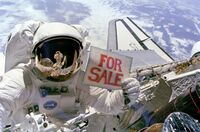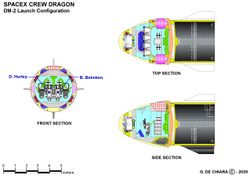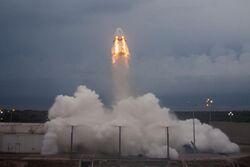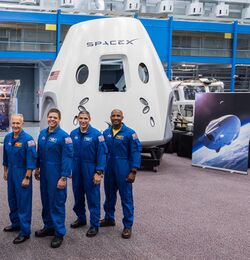Software:SpaceX Dragon 2
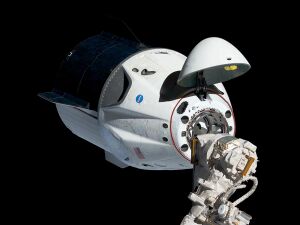 Crew Dragon approaching the ISS in March 2019, during Demo-1 | |
| Manufacturer | SpaceX |
|---|---|
| Country of origin | United States |
| Operator | SpaceX |
| Applications | ISS crew and cargo transport |
| Specifications | |
| Design life | |
| Dry mass | 9,525 kg (20,999 lb)[3] |
| Payload capacity | |
| Crew capacity | 7 (NASA missions will only have 4 crew members)[6] |
| Dimensions | |
| Volume |
|
| Production | |
| Status | Active |
| Built | 4 (1 test article, 3 flightworthy) |
| Launched | 2 (+1 suborbital) |
| Lost | 1 (in testing) |
| Maiden launch | 2 March 2019 (Uncrewed test) 30 May 2020 (Crewed) |
| Related spacecraft | |
| Derived from | SpaceX Dragon |
| Original author(s) | SpaceX |
|---|---|
| Written in | C++, JavaScript[7][8] |
| Engine | Chromium browser (Crew Dragon only)[7] |
| Operating system | Linux[9] |
| Platform | |
| Included with | Dragon 2 |
| Size | Around 100K source lines[10] |
| Available in | English |
| Type | Application-specific system software |
| License | Closed source, internal use |
| Part of a series on |
| Private spaceflight |
|---|
| Active companies |
| Flown vehicles |
| Contracts and programs |
|
|
The SpaceX Dragon 2 is a class of reusable spacecraft developed and manufactured by American aerospace manufacturer SpaceX as the successor to the Dragon cargo spacecraft. It has two variants: Crew Dragon, a human-rated capsule capable of ferrying up to seven astronauts, and Cargo Dragon, an updated replacement for the original Dragon spacecraft. The spacecraft launches atop a Falcon 9 Block 5 rocket and returns to Earth via an ocean splashdown. Unlike its predecessor, the spacecraft can dock itself to the ISS instead of being berthed. Crew Dragon is equipped with an integrated launch escape system (LES) capable of accelerating the vehicle away from the rocket in an emergency at 11.8 m/s2, accomplished by using a set of four side-mounted thruster pods with two SuperDraco engines each. The spacecraft features redesigned solar arrays and a modified outer mold line compared to the original Dragon, and possess new flight computers and avionics. As of March 2020, four Dragon 2 spacecraft have been manufactured (not counting structural test articles that were never airborne).
Crew Dragon serves as one of two spacecraft that is expected to transport crews to and from the International Space Station (ISS) under NASA's Commercial Crew Program, the other being the Boeing CST-100 Starliner. It is also expected to be used in flights by American space tourism company Space Adventures and to shuttle tourists to and from Axiom Space's planned space station. Crew Dragon's first non-piloted test flight occurred in March 2019, and its first crewed flight – with astronauts Robert Behnken and Douglas Hurley – occurred in May 2020. This test flight marked the first time a private company launched a crewed orbital spacecraft. Cargo Dragon is expected to supply cargo to the ISS under a Commercial Resupply Services-2 contract with NASA, along with Northrop Grumman Innovation Systems' Cygnus spacecraft and Sierra Nevada Corporation's Dream Chaser spacecraft. The first flight of the Cargo Dragon is planned to launch in October 2020.
Development and variants
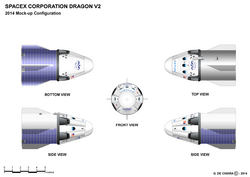
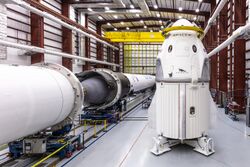
There are two variants: Crew Dragon and Cargo Dragon.[5] Crew Dragon was initially called DragonRider[11][12] and it was intended from the beginning to support a crew of seven or a combination of crew and cargo.[13][14] It is able to perform fully autonomous rendezvous and docking with manual override ability, using the NASA Docking System (NDS).[15][16] For typical missions, Crew Dragon will remain docked to the ISS for a period of 180 days, but is designed to remain on the station for up to 210 days, matching the Russian Soyuz spacecraft.[17][18][19] From the beginning of the development process, SpaceX planned to use an integrated pusher launch escape system for the Dragon spacecraft.[20][21][22]
Crew Dragon
SpaceX originally intended to land Crew Dragon on land using the LES engines, with parachutes and an ocean splashdown available in the case of an aborted launch. Precision water landing under parachutes was proposed to NASA as "the baseline return and recovery approach for the first few flights" of Crew Dragon.[23] Propulsive landing was later cancelled, leaving ocean splashdown under parachutes as the only option.[24] (As of 2011), the Paragon Space Development Corporation was assisting in developing Crew Dragon's life-support system.[25]
In 2012, SpaceX was in talks with Orbital Outfitters about developing space suits to wear during launch and re-entry.[26] Each crew member wears a custom space suit fitted for them. The suit is primarily designed for use inside the Dragon (IVA type suit): however, in the case of a rapid cabin depressurization, the suit can protect the crew members. The suit can also provide cooling for astronauts during normal flight.[27][28] For the Demo-1 mission, a test dummy nicknamed Ripley was fitted with the spacesuit and sensors. The spacesuit "is made from Nomex", a fire retardant fabric similar to Kevlar.
At a NASA news conference on 18 May 2012, SpaceX confirmed their target launch price for crewed Dragon flights of US$160 million, or about US$23 million per seat if the maximum crew of seven is aboard and NASA orders at least four Crew Dragon flights per year.[29] This contrasts with the 2014 Soyuz launch price of US$76 million per seat for NASA astronauts.[30] The spacecraft's design was unveiled on 29 May 2014, during a press event at SpaceX headquarters in Hawthorne, California .[31][32][33] In October 2014, NASA selected the Dragon spacecraft as one of the candidates to fly American astronauts to the International Space Station, under the Commercial Crew Program.[34][35][36] SpaceX is using the Falcon 9 Block 5 launch vehicle to launch Dragon 2.[4]
Cargo Dragon
Although Dragon 2 was intended from the earliest design concept to carry crew, or with fewer seats, both crew and cargo, a second round of multi-year cargo supply contracts (also known as CRS2) was solicited by NASA in 2014, to supply the ISS in 2020–2024. This led to SpaceX proposing a separately-named model, Cargo Dragon, for the NASA flights.[37] SpaceX won a contract award for Cargo Dragon as a result of the CRS2 bid competition, with contracts awarded in January 2016 for six flights.[38]
Design
Dragon 2 includes the following features:[31][32][39]
Dragon 2 is partially reusable, potentially resulting in a significant cost reduction. SpaceX planned to use new capsules for every crewed flight for NASA but is looking at reusing the capsules.[40] Cargo Dragon can carry 3,307 kilograms (7,291 lb) to the ISS; Crew Dragon has a capacity of seven astronauts (only four seats are used for NASA missions). Above the seats, there is a three-screen control panel, a toilet (with privacy curtain), and the docking hatch. Ocean landings are accomplished with four main parachutes in both variants. The parachute system was fully redesigned from the one used in the prior Dragon capsule, due to the need to deploy the parachutes under a variety of launch abort scenarios.[41]
Crew Dragon has eight side-mounted SuperDraco engines, clustered in redundant pairs in four engine pods, with each engine able to produce 71 kilonewtons (16,000 lbf) of thrust to be used for launch aborts.[31] Each pod also contains four Draco thrusters that can be used for attitude control and orbital maneuvers. The SuperDraco engine combustion chamber is printed of Inconel, an alloy of nickel and iron, using a process of direct metal laser sintering. Engines are contained in a protective nacelle to prevent fault propagation if an engine fails.
Once in orbit, Dragon 2 is able to autonomously dock to the ISS. Dragon used berthing, a non-autonomous means to attach to the ISS that was completed by use of the Canadarm2 robotic arm. Pilots of Crew Dragon retain the ability to dock the spacecraft using manual controls interfaced with a static tablet-like computer. The spacecraft can be operated in full vacuum, and "the crew will wear SpaceX-designed space suits to protect them from a rapid cabin depressurization emergency event". Also, the spacecraft will be able to return safely if a leak occurs "of up to an equivalent orifice of 6.35 mm [0.25 in] in diameter".[23]
Propellant and helium pressurant for both launch aborts and on-orbit maneuvering is contained in composite-carbon-overwrap titanium spherical tanks. A PICA-X heat shield protects the capsule during reentry, while a movable ballast sled allows more precise attitude control of the spacecraft during the atmospheric entry phase of the return to Earth and more accurate control of the landing ellipse location.[23] A reusable nose cone "protects the vessel and the docking adaptor during ascent and reentry",[23] pivoting on a hinge to enable in-space docking and returning to the covered position for reentry and future launches.[33]
The trunk is the third structural element of the spacecraft, containing solar panels, heat-removal radiators, and fins to provide aerodynamic stability during emergency aborts.[23]
The previous Cargo Dragon's deployable solar arrays have been eliminated and are now built into the trunk itself. This increases volume space, reduces the number of mechanisms on the vehicle and further increases reliability.
Crewed flights
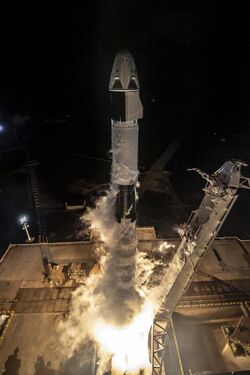
Dragon is intended to fulfill a set of requirements that will make the capsule useful to both commercial and government customers. SpaceX and Bigelow Aerospace were working together to support round-trip transport of commercial passengers to low Earth orbit (LEO) destinations, but the plan was canceled. Instead Axiom plans to launch tourists to the Space Station and eventually their own private space station. NASA flights to the ISS will only have four astronauts, with the added payload mass and volume used to carry pressurized cargo.[41]
On 16 September 2014, NASA announced that SpaceX and Boeing had been selected to provide crew transportation to the ISS. SpaceX will receive US$2.6 billion under this contract.[42] Dragon was the least expensive proposal,[35] but NASA's William H. Gerstenmaier considered the CST-100 proposal the stronger of the two.
In a departure from the prior NASA practice, where construction contracts with commercial firms led to direct NASA operation of the spacecraft, NASA is purchasing space transport services from SpaceX, including construction, launch, and operation of the Dragon 2.[43]
In August 2018, NASA and SpaceX agreed on the loading procedures for propellants, vehicle fluids and crew. High-pressure helium will be loaded first, followed by the passengers approximately two hours prior to scheduled launch; the ground crew will then depart the launch pad and move to a safe distance. The launch escape system will be activated approximately 40 minutes prior to launch, with propellant loading commencing several minutes later.[44] The first automated test mission launched to the International Space Station (ISS) on 2 March 2019.[45]
In early 2019, crewed flights were expected to begin no earlier than July 2019.[46] They were later planned to begin no earlier than on 30 May 2020. The first crewed flight launched on 30 May 2020[47] with the launch of the Demo-2 mission.
In June 2019, Bigelow Space Operations announced it had reserved with SpaceX up to four missions of four passengers each to ISS as early as 2020 and planned to sell them for around US$52 million per seat.[48] These plans were canceled by September 2019.
On 18 February 2020, building on development for NASA's commercial crew program, Space Adventures announced an agreement with SpaceX to fly up to four paying space tourists on a standalone mission aboard a Crew Dragon spacecraft in late 2021 or 2022 that could reach an altitude two-to-three times higher than the International Space Station.[49]
Testing
SpaceX planned a series of four flight tests for the Crew Dragon - a "pad abort" test, an uncrewed orbital flight to the ISS, an in-flight abort test, and finally a 14-day crewed demonstration mission to the ISS,[50] which was initially planned for July 2019,[46] but after a Dragon capsule explosion, was delayed to May 2020.[51]
Pad abort and hover tests
The pad abort test was conducted successfully on 6 May 2015 at SpaceX's leased SLC-40.[41] Dragon landed safely in the ocean to the east of the launchpad 99 seconds after ignition of the SuperDraco engines.[52] While a flight-like Dragon 2 and trunk were used for the pad abort test, they rested atop a truss structure for the test rather than a full Falcon 9 rocket. A crash test dummy embedded with a suite of sensors was placed inside the test vehicle to record acceleration loads and forces at the crew seat, while the remaining six seats were loaded with weights to simulate full-passenger-load weight.[43][53] The test objective was to demonstrate sufficient total impulse, thrust and controllability to conduct a safe pad abort. A fuel mixture ratio issue was detected after the flight in one of the eight SuperDraco engines causing it to under perform, but did not materially affect the flight.[54][55][56]
On 24 November 2015, SpaceX conducted a test of Dragon 2's hovering abilities at the firm's rocket development facility in McGregor, Texas . In a video, the spacecraft is shown suspended by a hoisting cable and igniting its SuperDraco engines to hover for about 5 seconds, balancing on its 8 engines firing at reduced thrust to compensate exactly for gravity.[57] The test vehicle was the same capsule that performed the pad abort test earlier in 2015; it was nicknamed DragonFly.[58]
Demo-1: orbital flight test
In 2015, NASA named its first Commercial Crew astronaut cadre of four veteran astronauts to work with SpaceX and Boeing – Robert Behnken, Eric Boe, Sunita Williams, and Douglas Hurley.[59] The Demo-1 mission completed the last milestone of the Commercial Crew Development program, paving the way to starting commercial services under an upcoming ISS Crew Transportation Services contract.[43][60] On 3 August 2018, NASA announced the crew for the DM-2 mission.[61] The crew of two will be formed by NASA astronauts Bob Behnken and Doug Hurley. Behnken previously flew as mission specialist on the STS-123 and the STS-130 missions. Hurley previously flew as a pilot on the STS-127 mission and on the final Space Shuttle mission, the STS-135 mission.
The first orbital test of Crew Dragon was an uncrewed mission, officially designated "Crew Demo-1" and launched on 2 March 2019.[62][63] The spacecraft tested the approach and automated docking procedures with the ISS,[64] remained docked until 8 March 2019, then conducted the full re-entry, splashdown and recovery steps to qualify for a crewed mission.[65][66] Life-support systems were monitored all along the test flight. The same capsule was planned to be re-used in June 2019 for an in-flight abort test before it exploded on 20 April 2019.[62][67]
Explosion during testing
On 20 April 2019, the Crew Dragon capsule used in the Demo-1 mission was destroyed in an explosion during static fire testing at the Landing Zone 1 facility.[68][69] On the day of the explosion, the initial testing of the Crew Dragon's Draco thrusters was successful, with the accident occurring during the test of the SuperDraco abort system.[70]
Telemetry, high-speed camera footage, and analysis of recovered debris indicate the problem occurred when a small amount of dinitrogen tetroxide leaked into a helium line used to pressurize the propellant tanks. The leakage apparently occurred during pre-test processing. As a result, the pressurization of the system 100 ms before firing damaged a check valve and resulted in the explosion.[70][71]
Since the destroyed capsule had been slated for use in the upcoming in-flight abort test, the explosion and investigation delayed that test and the subsequent crewed orbital test.[72]
The SuperDraco engine test that failed on 20 April 2019 was repeated successfully on 13 November 2019. The full duration static fire test of Crew Dragon's launch escape system took place at Cape Canaveral Air Force Station at SpaceX's Landing Zone 1 at 20:08 UTC. The test was successful, showing that the modifications made to the vehicle to prevent a failure like the one that happened 20 April 2019 were successful. The vehicle used for this ground test would also be used for the following in-flight abort test.[73]
Some of the modifications are:
- Replacement of the valves with burst discs: Unlike valves, burst discs are designed for single use.
- Addition of flaps on each SuperDraco in order to reseal the thrusters prior to splashdown in the ocean, preventing water intrusion.[74]
In-flight abort test
The Crew Dragon in-flight abort test was launched on 19 January 2020 at 15:30 UTC from Launch Complex 39A on a suborbital trajectory to conduct a separation and abort scenario in the troposphere at transonic velocities shortly after passing through max Q, where the vehicle experiences maximum aerodynamic pressure. The Dragon 2 used its SuperDraco abort engines to push itself away from the Falcon 9 after an intentional premature engine cutoff. Ten seconds after Dragon 2 was jettisoned, the Falcon 9 exploded and was destroyed. The spacecraft followed its suborbital trajectory to apogee, at which point the spacecraft's trunk was jettisoned. The smaller Draco engines were then used to orient the vehicle for the descent. All major functions were executed, including separation, engine firings, parachute deployment, and landing. Dragon 2 splashed down at 15:38:54 UTC just off the Florida coast in the Atlantic Ocean.[75] The test objective was to demonstrate the ability to safely move away from the ascending rocket under the most challenging atmospheric conditions of the flight trajectory, imposing the worst structural stress of a real flight on the rocket and spacecraft.[41] The abort test was performed using a Falcon 9 Block 5 rocket with a fully fueled second stage with a mass simulator replacing the Merlin engine.[76]
Earlier, this test had been scheduled before the uncrewed orbital test,[77] however, SpaceX and NASA considered it safer to use a flight representative capsule rather than the test article from the pad abort test.[78]
This test was previously planned to use the capsule C201 from Demo-1, however, C201 was destroyed in an explosion during a static fire testing on 20 April 2019.[79] Capsule C205, originally planned for Demo-2 was used for the In-Flight Abort Test[80] with C206 being planned for use during Demo-2. This was the final flight test of the spacecraft before it began carrying astronauts to the International Space Station under NASA's Commercial Crew Program.
Prior to the flight test, teams completed launch day procedures for the first crewed flight test, from suit-up to launch pad operations. The joint teams conducted full data reviews that needed to be completed prior to NASA astronauts flying on the system during SpaceX's Demo-2 mission.[81]
Demo-2: crewed orbital flight test
On 17 April 2020, NASA Administrator Jim Bridenstine announced the first crewed Crew Dragon Demo-2 to the International Space Station would launch on 27 May 2020.[82] Astronauts Bob Behnken and Doug Hurley crewed the mission, marking the first crewed launch to the International Space Station from US soil since STS-135 in July 2011. The original launch was postponed to 30 May 2020 due to weather conditions at the launch site.[83] The second launch attempt was successful, with capsule C206, later named Endeavour by the crew, launching on 30 May 2020 19:22 UTC.[84][85] The capsule successfully docked with the International Space Station on 31 May 2020 at 14:27 UTC.[86]
Launching in the Dragon 2 spacecraft was described by astronaut Bob Behnken as "smooth off the pad" but "we were definitely driving and riding a dragon all the way up... a little bit less g's [than the Space Shuttle] but more 'alive' is probably the best way I would describe it".[87]
List of vehicles
| Image | Serial | Name | Status | Flights | Time in flight | Notes | Cat. | |
|---|---|---|---|---|---|---|---|---|

|
C200 | DragonFly | Retired | 1 | 1m | Prototype used for hover tests at the McGregor Test Facility and a pad abort test at Cape Canaveral Air Force Station . | ||

|
C201 | None | Destroyed | 1 | 6d 5h 56m | First vehicle to fly in space. Only flight was Crew Demo-1; destroyed during testing. | ||
| C202 | None | Unknown | 0 | None | Pressure vessel used for structural testing; status unknown. | |||
| C203 | None | Unknown | 0 | None | Purpose and status unknown.[91][92] | |||
| C204 | None | Unknown | 0 | None | ||||

|
C205 | None | Active | 1 | 8m | First flown during the Crew Dragon In-Flight Abort Test; future use to be determined.[89][92] | ||

|
C206 | Endeavour | Active | 1 | 1506 days, 15 hours and 25 minutes | First vehicle to carry crew; named after Space Shuttle Endeavour. First flown during Crew Demo-2.[93] | ||

|
C207 | TBD | Under construction | 0 | None | First full-production Crew Dragon; planned first flight is SpaceX Crew-1. | ||
| Test vehicle Spaceflight vehicle |
List of flights
As of June 2020, there are nine Crew Dragon flights contracted to carry crew, seven are contracted by NASA (one crewed test flight and six operational crew rotation missions),[94] and two (one each) contracted by private companies Axiom Space[95] and Space Adventures.[96]
| Mission | Patch | Capsule[90] | Launch date | Description | Crew | Outcome |
|---|---|---|---|---|---|---|
| Crew Dragon flights | ||||||
| Pad Abort Test | C200 DragonFly | 6 May 2015 | Pad Abort Test, Cape Canaveral Air Force Station, Florida.[97] | N/A | Success | |
| Demo-1 | 
|
C201 | 2 March 2019[62] | Uncrewed test flight of the Crew Dragon capsule; docked 3 March 2019, 08:50 UTC; departed 8 March 2019, 05:32 UTC. | N/A | Success |
| In-Flight Abort Test | C205 | 19 January 2020[98] | Used the capsule originally planned for Crew Dragon Demo-2.[99] | N/A | Success | |
| Demo-2 | 
|
C206 Endeavour | 30 May 2020[100][101] | First crewed flight test of Dragon capsule, flight extended from two weeks to 6-16 weeks in order to allow the crew to bolster activity on the ISS ahead of Crew-1, including partaking in four planned spacewalks. | Docked to ISS | |
| Crew-1 | 
|
C207 | NET 21 September 2020[102] | Will transport four astronauts to the ISS for a six-month mission. Will not fly a Russian cosmonaut on board as Roscosmos has not yet certified the Crew Dragon vehicle as flight proven, so a third NASA astronaut was added instead of a Russian cosmonaut.[103] | Planned | |
| Crew-2 | TBA | TBA | NET February 2021[102] | Will transport four astronauts to the ISS for a six-month mission. This flight may mark the first SpaceX Crew flight to carry a Russian cosmonaut, as Roscosmos has stated they want each vehicle to have flown an operational flight before they put a cosmonaut on board.[104] | TBA |
Planned |
| Axiom Space mission | TBA | TBA | H2 2021[95] | First Crew Dragon flight contracted by Axiom Space. First fully private flight to the ISS, carrying one Axiom professional astronaut and three private astronauts for a 10-day trip.[105][106] NASA agreed to allow SpaceX to reuse boosters and capsules for this flight. | Planned | |
| Space Adventures mission | TBA | TBA | late 2021/2[49] | Up to four space tourists in a flight around 3 days, up to 5 days, on an elliptical orbit with the apogee three times that of the ISS, higher than the Earth orbital altitude record set by Gemini 11 in 1966.[49][107] |
|
Planned |
| Crew-3 to Crew-6 | TBA | TBA | NET 2022-2026 | Four more flights contracted under CCP contract.[108] | Planned | |
| Cargo Dragon flights | ||||||
| CRS-21 | TBA | TBA[109] | 30 October 2020[110] | First SpaceX mission contracted under the CRS-2 contract with NASA, will also mark the first flight of Cargo Dragon 2 and deliver the NanoRacks Bishop Airlock Module to the ISS. | N/A | Planned |
| CRS-22 | TBA | TBA[109] | 12 March 2021[111] | Second Cargo Dragon 2 flight to the ISS. | N/A | Planned |
| CRS-23 to CRS-26 | TBA | TBA[109] | NET 2021-2024[112] | Following CRS-22, NASA has so far contracted four follow on Cargo Dragon 2 flights to the ISS under CRS-2.[112] | N/A | Planned |
See also
- Comparison of crewed space vehicles
- Comparison of space station cargo vehicles
- List of crewed spacecraft
- Private spaceflight
Other crewed orbital spacecraft
- Gaganyaan
- Next-generation crewed spacecraft
- Orel (spacecraft)
- Orion (spacecraft)
- Shenzhou (spacecraft)
- SpaceX Starship
References
- ↑ "DragonLab datasheet" (PDF). Hawthorne, California: SpaceX. 8 September 2009. Archived from the original on 4 January 2011. https://web.archive.org/web/20110104010401/http://www.spacex.com/downloads/dragonlab-datasheet.pdf.
- ↑ ""Commercial Crew Program American Rockets American Spacecraft American Soil" (page 15)". NASA. https://www.nasa.gov/sites/default/files/atoms/files/commercialcrew_press_kit.pdf.
 This article incorporates text from this source, which is in the public domain.
This article incorporates text from this source, which is in the public domain.
- ↑ "SpaceX, NASA Discuss Forthcoming Dragon Pad Abort Test". 1 May 2015. https://www.americaspace.com/2015/05/01/spacex-nasa-discuss-forthcoming-dragon-pad-abort-test/.
- ↑ 4.0 4.1 4.2 4.3 4.4 4.5 SpaceX (1 March 2019). "Dragon". SpaceX. https://www.spacex.com/dragon.
- ↑ 5.0 5.1 Audit of Commercial Resupply Services to the International Space Station. NASA. 26 April 2018. Report No. IG-18-016. Quote: "For SpaceX, certification of the company's unproven cargo version of its Dragon 2 spacecraft for CRS-2 missions carries risk while the company works to resolve ongoing concerns related to software traceability and systems engineering processes".
 This article incorporates text from this source, which is in the public domain.
This article incorporates text from this source, which is in the public domain.
- ↑ Clark, Stephen (7 December 2019). "After redesigns, the finish line is in sight for SpaceX's Crew Dragon spaceship". Spaceflight Now. https://spaceflightnow.com/2019/12/07/after-redesigns-the-finish-line-is-in-sight-for-spacexs-crew-dragon/. "'With [the addition of parachutes] and the angle of the seats, we could not get seven anymore', Shotwell said. 'So now we only have four seats. That was kind of a big change for us'."
- ↑ 7.0 7.1 Tarajevits, Thomas. "Revisions to What computer and software is used by the Falcon 9?". https://space.stackexchange.com/posts/9446/revisions. Tarazevits says in his comment that he learned those information at "Engineer the Future" session with Jinnah Hussein.
- ↑ "r/IAmA - We are SpaceX Software Engineers - We Launch Rockets into Space - AMA". https://www.reddit.com/r/IAmA/comments/1853ap/we_are_spacex_software_engineers_we_launch/.
- ↑ "r/IAmA - Comment by u/spacexdevtty on "We are SpaceX Software Engineers - We Launch Rockets into Space - AMA"". https://www.reddit.com/r/IAmA/comments/1853ap/we_are_spacex_software_engineers_we_launch/c8bodrj.
- ↑ "r/IAmA - Comment by u/spacexdevtty on "We are SpaceX Software Engineers - We Launch Rockets into Space - AMA"". https://www.reddit.com/r/IAmA/comments/1853ap/we_are_spacex_software_engineers_we_launch/c8bqwtl.
- ↑ "Final Environmental Assessment for Issuing an Experimental Permit to SpaceX for Operation of the DragonFly Vehicle at the McGregor Test Site, McGregor, Texas". Federal Aviation Administration. pp. 2–3. http://www.faa.gov/about/office_org/headquarters_offices/ast/media/DragonFly_Final_EA_sm.pdf.
 This article incorporates text from this source, which is in the public domain.
This article incorporates text from this source, which is in the public domain.
- ↑ Gwynne Shotwell (21 March 2014). Broadcast 2212: Special Edition, interview with Gwynne Shotwell (audio file). The Space Show. Event occurs at 24:05–24:45 and 28:15–28:35. 2212. Archived from the original (mp3) on 22 March 2014. Retrieved 22 March 2014.
we call it v2 for Dragon. That is the primary vehicle for crew, and we will retrofit it back to cargo.
- ↑ "Q+A: SpaceX Engineer Garrett Reisman on Building the World's Safest Spacecraft". PopSci. 13 April 2012. http://www.popsci.com/technology/article/2012-04/qa-former-astronaut-and-spacex-engineer-garrett-reisman-building-worlds-safest-spacecraft. "DragonRider, SpaceX's crew-capable variant of its Dragon capsule"
- ↑ "SpaceX Completes Key Milestone to Fly Astronauts to International Space Station". SpaceX. 20 October 2011. http://www.spacex.com/press.php?page=20111020.
- ↑ "Dragon Overview". SpaceX. http://www.spacex.com/dragon.php.
- ↑ Parma, George (20 March 2011). "Overview of the NASA Docking System and the International Docking System Standard" (PDF). NASA. Archived from the original on 15 October 2011. https://web.archive.org/web/20111015075220/http://dockingstandard.nasa.gov/Documents/AIAA_ATS_NDS-IDSS_Overview_Draft1.pdf. "iLIDS was later renamed the NASA Docking System (NDS), and will be NASA's implementation of an IDSS compatible docking system for all future US vehicles"
 This article incorporates text from this source, which is in the public domain.
This article incorporates text from this source, which is in the public domain.
- ↑ Bayt, Rob (16 July 2011). "Commercial Crew Program: Key Driving Requirements Walkthrough". NASA. Archived from the original on 28 March 2012. https://web.archive.org/web/20120328055242/http://commercialcrew.nasa.gov/document_file_get.cfm?docid=107.
 This article incorporates text from this source, which is in the public domain.
This article incorporates text from this source, which is in the public domain.
- ↑ Oberg, Jim (28 March 2007). "Space station trip will push the envelope". NBC News. http://www.nbcnews.com/id/17815821.
- ↑ Bolden, Charles (9 May 2012). "2012-05-09_NASA_Response" (PDF). NASA. http://oiir.hq.nasa.gov/asap/documents/responses/nasa/2012-05-09_NASA_Response.pdf.
 This article incorporates text from this source, which is in the public domain.
This article incorporates text from this source, which is in the public domain.
- ↑ With the exception of the Project Gemini spacecraft, which used twin ejection seats: "Encyclopedia Astronautica: Gemini Ejection" . Astronautix.com. Retrieved 24 January 2013.
- ↑ Chow, Denise (18 April 2011). "Private Spaceship Builders Split Nearly $270 Million in NASA Funds". New York: Space.com. Archived from the original on 18 December 2011. https://www.webcitation.org/6415KG6df?url=http://www.space.com/11421-nasa-private-spaceship-funding-astronauts.html.
- ↑ "Spaceship teams seek more funding". MSNBC Cosmic Log. 10 December 2010. Retrieved 14 December 2010.
- ↑ 23.0 23.1 23.2 23.3 23.4 Reisman, Garrett (27 February 2015). "Statement of Garrett Reisman, Director of Crew Operations, Space Explorations Technologies Corp. (SpaceX) before the Subcommittee on Space, Committee on Science, Space, and Technology, U.S. House of Representatives" (pdf). United States House of Representatives, Committee on Science, Space, and Technology. https://science.house.gov/imo/media/doc/Reisman%20Testimony.pdf. (document source: SpaceX)
 This article incorporates text from this source, which is in the public domain.
This article incorporates text from this source, which is in the public domain.
- ↑ "SpaceX Updates – Taking the next step: Commercial Crew Development Round 2". SpaceX. 17 January 2010. http://www.spacex.com/updates.php.
- ↑ "In the news Paragon Space Development Corporation Joins SpaceX Commercial Crew Development Team". Paragon Space Development Corporation. 16 June 2011. Archived from the original on 7 January 2012. https://web.archive.org/web/20120107054003/http://www.paragonsdc.com/press_paragon-joins-spacex.php.
- ↑ Sofge, Eric (19 November 2012). "The Deep-Space Suit". PopSci. http://www.popsci.com/technology/article/2012-10/deep-space-suit.
- ↑ "Dragon". SpaceX. https://www.spacex.com/dragon.
- ↑ Gibbens, Sarah. "A First Look at the Spacesuits of the Future". https://www.nationalgeographic.com.au/space/a-first-look-at-the-spacesuits-of-the-future.aspx.
- ↑ Star Wars: The Battle to Build the Next Shuttle: Boeing, SpaceX and Sierra Nevada. Bloomberg News. May 2014. Event occurs at 2:05. Retrieved 6 May 2014.
- ↑ "SpaceX scrubs launch to ISS over rocket engine problem". Deccan Chronicle. 19 May 2012. Archived from the original on 23 May 2012. https://web.archive.org/web/20120523003837/http://www.deccanchronicle.com/channels/sci-tech/space/spacex-scrubs-launch-iss-over-rocket-engine-problem-933.
- ↑ 31.0 31.1 31.2 Norris, Guy (30 May 2014). "SpaceX Unveils 'Step Change' Dragon 'V2'". Aviation Week. http://aviationweek.com/space/spacex-unveils-step-change-dragon-v2.
- ↑ 32.0 32.1 Kramer, Miriam (30 May 2014). "SpaceX Unveils Dragon V2 Spaceship, a Manned Space Taxi for Astronauts — Meet Dragon V2: SpaceX's Manned Space Taxi for Astronaut Trips". space.com. http://www.space.com/26063-spacex-unveils-dragon-v2-manned-spaceship.html.
- ↑ 33.0 33.1 Bergin, Chris (30 May 2014). "SpaceX lifts the lid on the Dragon V2 crew spacecraft". NASAspaceflight.com. http://www.nasaspaceflight.com/2014/05/spacex-lifts-the-lid-dragon-v2-crew-spacecraft/.
- ↑ Post, Hannah (16 September 2014). "NASA Selects SpaceX to be Part of America's Human Spaceflight Program". https://www.spacex.com/news/2014/09/16/nasa-selects-spacex-be-part-americas-human-spaceflight-program.
- ↑ 35.0 35.1 11 Oct; First, 2014 Guy Norris | AWIN. "Why NASA Rejected Sierra Nevada's Commercial Crew Vehicle". https://aviationweek.com/space/why-nasa-rejected-sierra-nevadas-commercial-crew-vehicle.
- ↑ Berger, Eric (9 June 2017). "So SpaceX is having quite a year". Ars Technica. https://arstechnica.com/science/2017/06/so-spacex-is-having-quite-a-year/.
- ↑ Bergin, Chris. "NASA lines up four additional CRS missions for Dragon and Cygnus". NASASpaceFlight.com. http://www.nasaspaceflight.com/2015/03/nasa-crs-missions-dragon-cygnus/.
- ↑ "Sierra Nevada Corp. joins SpaceX and Orbital ATK in winning NASA resupply contracts". Washington Post. 14 January 2016. https://www.washingtonpost.com/news/the-switch/wp/2016/01/14/nasa-expected-to-soon-announce-contracts-to-resupply-the-international-space-station/.
- ↑ Clark, Stephen (9 October 2014). "NASA clears commercial crew contractors to resume work". Spaceflight Now. http://spaceflightnow.com/news/n1410/09cctcap/#.VDgLfBaum5d. "a highly-modified second-generation Dragon capsule fitted with myriad upgrades and changes – including new rocket thrusters, computers, a different outer mold line, and redesigned solar arrays – from the company's Dragon cargo delivery vehicle already flying to the space station."
- ↑ Sheetz, Michael (10 March 2020). "SpaceX on track to launch first NASA astronauts in May, president says". CNBC. https://www.cnbc.com/2020/03/10/spacex-aiming-for-may-astronaut-launch-will-reuse-crew-dragon.html.
- ↑ 41.0 41.1 41.2 41.3 Bergin, Chris (28 August 2014). "Dragon V2 will initially rely on parachute landings". NASAspaceflight.com. http://www.nasaspaceflight.com/2014/08/dragon-v2-rely-parachutes-landing/.
- ↑ "NASA Chooses American Companies to Transport U.S. Astronauts to International Space Station". http://www.nasa.gov/press/2014/september/nasa-chooses-american-companies-to-transport-us-astronauts-to-international/.
 This article incorporates text from this source, which is in the public domain.
This article incorporates text from this source, which is in the public domain.
- ↑ 43.0 43.1 43.2 Bergin, Chris (5 March 2015). "Commercial crew demo missions manifested for Dragon 2 and CST-100". NASASpaceFlight.com. http://www.nasaspaceflight.com/2015/03/commercial-crew-demo-missions-dragon-cst-100/.
- ↑ Garcia, Mark (17 August 2018). "NASA, SpaceX Agree on Plans for Crew Launch Day Operations". NASA. https://www.nasa.gov/feature/nasa-spacex-agree-on-plans-for-crew-launch-day-operations/.
- ↑ "NASA's Commercial Crew Program Target Test Flight Dates". NASA. 21 November 2018. https://blogs.nasa.gov/commercialcrew/2018/11/21/nasas-commercial-crew-program-target-test-flight-dates-5/.
 This article incorporates text from this source, which is in the public domain.
This article incorporates text from this source, which is in the public domain.
- ↑ 46.0 46.1 "NASA, Partners Update Commercial Crew Launch Dates". NASA Commercial Crew Program Blog. 6 February 2019. https://blogs.nasa.gov/commercialcrew/2019/02/06/.
 This article incorporates text from this source, which is in the public domain.
This article incorporates text from this source, which is in the public domain.
- ↑ Chan, Athena (17 April 2020). "Elon Musk Shares Simulation Video, Schedule Of Crew Dragon's First Crewed Flight". https://spaceflightnow.com/2020/04/17/soyuz-with-crew-of-three-lands-safely-in-kazakhstan/.
- ↑ "So, You Want to Be a Space Tourist?". 11 June 2019. https://observer.com/2019/06/international-space-station-commercial-business-tourism/.
- ↑ 49.0 49.1 49.2 Clark, Stephen (18 February 2020). "Space Adventures announces plans to fly private citizens on SpaceX crew capsule". Spaceflight Now. https://spaceflightnow.com/2020/02/18/space-adventures-announces-plans-to-launch-private-citizens-on-spacex-crew-capsule/.
- ↑ "S.S. John Glenn freighter departs space station after successful cargo delivery – Spaceflight Now". http://spaceflightnow.com/2016/12/13/spacexs-first-crewed-launch-moved-back-to-2018/SpaceX's.
- ↑ "NASA sets tentative date for launching astronauts in SpaceX ship". https://futurism.com/the-byte/nasa-tentative-spacex-launch-date.
- ↑ Clark, Stephen (6 May 2015). "SpaceX crew capsule completes dramatic abort test". http://spaceflightnow.com/2015/05/06/spacex-crew-capsule-completes-dramatic-abort-test/.
- ↑ Bergin, Chris (3 April 2015). "SpaceX preparing for a busy season of missions and test milestones". NASASpaceFlight.com. http://www.nasaspaceflight.com/2015/04/spacex-preparing-busy-season-missions-test-milestones/.
- ↑ "SpaceX Crew Dragon pad abort: Test flight demos launch escape system". 6 May 2015. http://www.collectspace.com/news/news-050615a-spacex-dragon-pad-abort.html.
- ↑ Bergin, Chris (6 May 2015). "Dragon 2 conducts Pad Abort leap in key SpaceX test". NASASpaceFlight.com. http://www.nasaspaceflight.com/2015/05/dragon-2-pad-abort-leap-key-spacex-test/.
- ↑ Clark, Stephen. "SpaceX crew capsule completes dramatic abort test – Spaceflight Now". https://spaceflightnow.com/2015/05/06/spacex-crew-capsule-completes-dramatic-abort-test/.
- ↑ Dragon 2 Propulsive Hover Test. SpaceX. 21 January 2016. Retrieved 21 January 2016.
- ↑ Bergin, Chris (21 October 2015). "SpaceX DragonFly arrives at McGregor for testing". NASASpaceFlight.com. http://www.nasaspaceflight.com/2015/10/spacex-dragonfly-arrives-mcgregor-testing/.
- ↑ "NASA assigns 4 astronauts to commercial Boeing, SpaceX test flights | collectSPACE". http://www.collectspace.com/news/news-070915a-commercial-crew-astronauts.html.
- ↑ Kramer, Miriam (27 January 2015). "Private Space Taxis on Track to Fly in 2017". Scientific American. http://www.scientificamerican.com/article/private-space-taxis-on-track-to-fly-in-2017/.
- ↑ "NASA Assigns Crews to First Test Flights, Missions on Commercial Spacecraft". NASA. 3 August 2018. https://www.nasa.gov/press-release/nasa-assigns-crews-to-first-test-flights-missions-on-commercial-spacecraft.
 This article incorporates text from this source, which is in the public domain.
This article incorporates text from this source, which is in the public domain.
- ↑ 62.0 62.1 62.2 "NASA, Partners Update Commercial Crew Launch Dates". NASA Commercial Crew Program Blog. 6 February 2019. https://blogs.nasa.gov/commercialcrew/2019/02/06/.
 This article incorporates text from this source, which is in the public domain.
This article incorporates text from this source, which is in the public domain.
- ↑ https://www.youtube.com/watch?v=2ZL0tbOZYhE
- ↑ "SpaceX Crew Dragon Hatch Open". NASA Blog. 3 March 2019. https://blogs.nasa.gov/spacestation/2019/03/03/spacex-crew-dragon-hatch-open/.
 This article incorporates text from this source, which is in the public domain.
This article incorporates text from this source, which is in the public domain.
- ↑ "Crew Demo 1 Mission Overview". SpaceX. March 2019. https://www.spacex.com/sites/spacex/files/crew_demo-1_press_kit.pdf.
- ↑ SpaceX #CrewDragon Demonstration Flight Return to Earth. NASA. 8 March 2019 – via YouTube.
- ↑ "SpaceX's Crew Dragon spacecraft suffers an anomaly during static fire testing at Cape Canaveral – NASASpaceFlight.com". https://www.nasaspaceflight.com/2019/04/spacexs-crew-dragon-spacecraft-anomaly-static-fire-testing/.
- ↑ @JimBridenstine (20 April 2019). "NASA has been notified about the results of the @SpaceX Static Fire Test and the anomaly that occurred during the final test. We will work closely to ensure we safely move forward with our Commercial Crew Program.". https://twitter.com/JimBridenstine/status/1119754804258062337.
- ↑ Mosher, Dave. "SpaceX confirmed that its Crew Dragon spaceship for NASA was 'destroyed' by a recent test. Here's what we learned about the explosive failure.". https://www.businessinsider.com/spacex-crew-dragon-spaceship-test-explosion-2019-5.
- ↑ 70.0 70.1 Shanklin, Emily (15 July 2019). "UPDATE: IN-FLIGHT ABORT STATIC FIRE TEST ANOMALY INVESTIGATION". SpaceX. https://www.spacex.com/news/2019/07/15/update-flight-abort-static-fire-anomaly-investigation.
- ↑ "Explosion that destroyed SpaceX Crew Dragon is blamed on leaking valve". CBS News. https://www.cbsnews.com/news/spacex-explosion-destroyed-crew-dragon-spacecraft-blamed-on-leaking-valve/.
- ↑ "NASA boss says no doubt SpaceX explosion delays flight program". 18 June 2019. https://www.journalpioneer.com/news/world/nasa-boss-says-no-doubt-spacex-explosion-delays-flight-program-323465/.
- ↑ Clark, Stephen. "SpaceX fires up Crew Dragon thrusters in key test after April explosion". Spaceflight Now. https://spaceflightnow.com/2019/11/13/spacex-fires-up-crew-dragon-thrusters-in-key-test-after-april-explosion/.
- ↑ Ralph, Eric (14 November 2019). "SpaceX fires up redesigned Crew Dragon as NASA reveals SuperDraco thruster "flaps"". https://www.teslarati.com/spacex-fires-redesigned-crew-dragon-superdraco-flaps/.
- ↑ Northon, Karen (19 January 2020). "NASA, SpaceX Complete Final Major Flight Test of Crew Spacecraft". NASA. http://www.nasa.gov/press-release/nasa-spacex-complete-final-major-flight-test-of-crew-spacecraft.
 This article incorporates text from this source, which is in the public domain.
This article incorporates text from this source, which is in the public domain.
- ↑ Richardson, Derek (30 July 2016). "Second SpaceX Crew Flight Ordered by NASA". Spaceflight Insider. http://www.spaceflightinsider.com/organizations/space-exploration-technologies/second-spacex-crew-flight-ordered-nasa/. "Currently, the first uncrewed test of the spacecraft is expected to launch in May 2017. Sometime after that, SpaceX plans to conduct an in-flight abort to test the SuperDraco thrusters while the rocket is traveling through the area of maximum dynamic pressure – Max Q."
- ↑ Foust, Jeff (4 February 2016). "SpaceX seeks to accelerate Falcon 9 production and launch rates this year". SpaceNews. http://spacenews.com/spacex-seeks-to-accelerate-falcon-9-production-and-launch-rates-this-year/. "Shotwell said the company is planning an in-flight abort test of the Crew Dragon spacecraft before the end of this year, where the vehicle uses its thrusters to separate from a Falcon 9 rocket during ascent. That will be followed in 2017 by two demonstration flights to the International Space Station, the first without a crew and the second with astronauts on board, and then the first operational mission."
- ↑ Siceloff, Steven (1 July 2015). "More Fidelity for SpaceX In-Flight Abort Reduces Risk". NASA. http://www.nasa.gov/feature/more-fidelity-for-spacex-in-flight-abort-reduces-risk/. "In the updated plan, SpaceX would launch its uncrewed flight test (DM-1), refurbish the flight test vehicle, then conduct the in-flight abort test prior to the crew flight test. Using the same vehicle for the in-flight abort test will improve the realism of the ascent abort test and reduce risk."
 This article incorporates text from this source, which is in the public domain.
This article incorporates text from this source, which is in the public domain.
- ↑ Shanklin, Emily (15 July 2019). "UPDATE: IN-FLIGHT ABORT STATIC FIRE TEST ANOMALY INVESTIGATION". SpaceX. https://www.spacex.com/news/2019/07/15/update-flight-abort-static-fire-anomaly-investigation.
- ↑ "SpaceX conducts successful Crew Dragon In-Flight Abort Test". 17 January 2020. https://www.nasaspaceflight.com/2020/01/spacex-crew-dragon-in-flight-abort-test/.
- ↑ Northon, Karen (19 January 2020). "NASA, SpaceX Complete Final Major Flight Test of Crew Spacecraft". NASA. https://www.nasa.gov/press-release/nasa-spacex-complete-final-major-flight-test-of-crew-spacecraft.
 This article incorporates text from this source, which is in the public domain.
This article incorporates text from this source, which is in the public domain.
- ↑ Bridenstine, Jim [@JimBridenstine] (17 April 2020). "BREAKING: On May 27, @NASA will once again launch American astronauts on American rockets from American soil! With our @SpaceX partners, @Astro_Doug and @AstroBehnken will launch to the @Space_Station on the #CrewDragon spacecraft atop a Falcon 9 rocket. Let's #LaunchAmerica pic.twitter.com/RINb3mfRWI". https://twitter.com/JimBridenstine/status/1251178705633841167.
- ↑ @SpaceX (27 May 2020). "Standing down from launch today due to unfavorable weather in the flight path. Our next launch opportunity is Saturday, May 30 at 19:22 UTC". https://twitter.com/SpaceX/status/1265739654810091520.
- ↑ @SpaceX (30 May 2020). "Liftoff!". https://twitter.com/SpaceX/status/1266812530833240064.
- ↑ @elonmusk (30 May 2020). "Replying to @NASA @SpaceX and 3 others Dragonship Endeavor". https://twitter.com/elonmusk/status/1266890648587776003.
- ↑ @SpaceX (31 May 2020). "Docking confirmed – Crew Dragon has arrived at the @space_station!". https://twitter.com/SpaceX/status/1267098143805435904.
- ↑ "We were suprised a little bit at how smooth things were off the pad ... and our expectation was as we continued with the flight into second stage that things would basically get a lot smoother than the Space Shuttle did, but Dragon was huffing and puffing all the way into orbit, and we were definitely driving and riding a dragon all the way up, and so it was not quite the same ride, the smooth ride as the Space Shuttle was up to MECO. A little bit less g's but a little bit more 'alive' is probably the best way I would describe it". NASA Astronauts Arrive at the International Space Station on SpaceX Spacecraft. 31 May 2020. Retrieved 31 May 2020 – via YouTube. at 3:46:02
- ↑ Gebhardt, Chris. "NASA briefly updates status of Crew Dragon anomaly, SpaceX test schedule". https://www.nasaspaceflight.com/2019/05/nasa-briefly-crew-dragon-anomaly-spacex-schedule/.
- ↑ 89.0 89.1 "List of Dragon Capsules". 21 May 2020. Archived from the original on 3 June 2020. https://web.archive.org/web/20200603193039/https://www.elonx.net/list-of-dragon-capsules/.
- ↑ 90.0 90.1 "Crew Dragon". https://space.skyrocket.de/doc_sdat/dragon-v2.htm.
- ↑ Ian Atkinson (10 October 2019). "SpaceX Crew Dragon in Flight Abort Test". NASA Spaceflight. https://www.nasaspaceflight.com/2020/01/spacex-crew-dragon-in-flight-abort-test/.
- ↑ 92.0 92.1 Ralph, Eric (19 January 2020). "SpaceX Crew Dragon spacecraft sails home after flawless in-flight abort test". Teslarati.com. Archived from the original on 20 January 2020. https://web.archive.org/web/20200120120054/https://www.teslarati.com/spacex-crew-dragon-sails-back-to-port-flawless-launch/.
- ↑ "NASA astronauts launch from U.S. soil for first time in nine years". 30 May 2020. https://spaceflightnow.com/2020/05/27/falcon-9-crew-dragon-demo-2-mission-status-center/.
- ↑ Beutel, Allard (7 April 2015). "NASA Chooses American Companies to Transport U.S. Astronauts to Intern". NASA. http://www.nasa.gov/press/2014/september/nasa-chooses-american-companies-to-transport-us-astronauts-to-international.
 This article incorporates text from this source, which is in the public domain.
This article incorporates text from this source, which is in the public domain.
- ↑ 95.0 95.1 Foust, Jeff (5 March 2020). "Axiom to fly Crew Dragon mission to the space station". SpaceNews. https://spacenews.com/axiom-to-fly-crew-dragon-mission-to-the-space-station/.
- ↑ "Space Adventures to fly tourists on Crew Dragon mission". 18 February 2020. https://spacenews.com/space-adventures-to-fly-tourists-on-crew-dragon-mission/.
- ↑ Clark, Stephen (6 May 2015). "SpaceX crew capsule completes dramatic abort test". http://spaceflightnow.com/2015/05/06/spacex-crew-capsule-completes-dramatic-abort-test/.
- ↑ Cooper, Ben (2 November 2019). "Rocket Launch Viewing Guide for Cape Canaveral". http://www.launchphotography.com/Delta_4_Atlas_5_Falcon_9_Launch_Viewing.html.
- ↑ "NASA Provides Update on SpaceX Crew Dragon Static Fire Investigation – Commercial Crew Program". NASA. https://blogs.nasa.gov/commercialcrew/2019/05/28/nasa-provides-update-on-spacex-crew-dragon-static-fire-investigation/.
- ↑ Clark, Stephen (17 April 2020). "NASA, SpaceX set May 27 as target date for first crew launch". Spaceflight Now. https://spaceflightnow.com/2020/04/17/nasa-spacex-set-may-27-as-target-date-for-first-crew-launch/.
- ↑ "Crew Dragon SpX-DM2". Spacefacts. http://www.spacefacts.de/mission/english/dragon_spx-dm2.htm.
- ↑ 102.0 102.1 "Schedule of ISS flight events (part 2)". https://forum.nasaspaceflight.com/index.php?topic=32006.1720.
- ↑ "NASA selects astronauts for Crew Dragon mission". 1 April 2020. https://spacenews.com/nasa-selects-astronauts-for-crew-dragon-mission/.
- ↑ https://ria.ru/20200306/1568224012.html
- ↑ Chang, Kenneth (5 March 2020). "There Are 2 Seats Left for This Trip to the International Space Station". https://www.nytimes.com/2020/03/05/science/axiom-space-station.html.
- ↑ O'Kane, Sean (5 March 2020). "SpaceX will send three tourists to the International Space Station next year". https://www.theverge.com/2020/3/5/21166657/spacex-tourists-iss-international-space-station-orbit-falcon-9-dragon.
- ↑ "SpaceX and Space Adventures to launch space tourism flight in 2022". CBS News. https://www.cbsnews.com/news/spacex-space-adventures-tourism-orbit-crew-dragon-2022/.
- ↑ "Boeing, SpaceX Secure Additional Crewed Missions Under NASA’s Commercial Space Transport Program". https://www.govconwire.com/2017/01/boeing-spacex-secure-additional-crewed-missions-under-nasas-commercial-space-transport-program/.
- ↑ 109.0 109.1 109.2 "Dragon CRS-21". Gunter's Space Page. https://space.skyrocket.de/doc_sdat/dragon-v2c.htm.
- ↑ "International Space Station Flight Schedule". http://spider.seds.org/shuttle/iss-sche.html.
- ↑ Hill, Denise (3 July 2016). "Upcoming ELaNa CubeSat Launches". http://www.nasa.gov/content/upcoming-elana-cubesat-launches.
- ↑ 112.0 112.1 "NASA Awards International Space Station Cargo Transport Contracts" (Press release). NASA. 14 January 2016.
 This article incorporates text from this source, which is in the public domain.
This article incorporates text from this source, which is in the public domain.
External links
